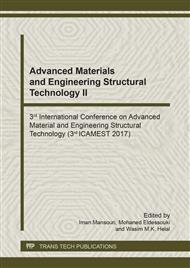p.1
p.8
p.17
p.22
p.27
p.33
p.39
p.44
Calculation and Analysis on the Soft Soil Foundation Settlement with Elastic-Visco-Plasticity (EVP) Model
Abstract:
The EVP model is an available method to apply to the vertical settlement of soft soil consolidation calculation and analysis. Compared with Visco-Plasticity model, it shows more consistent with the actual stress conditions of the soil. In this paper, We have extracted soil samples in BinHai garden for assay. Then through the comparison with calculating results and a long-time engineering monitoring in BinHai garden soft soil area, a feasibility EVP model study on the vertical settlement in soft soil area is peoposed. Further a consequent sedimentation forecast was made according with the EVP model calculation. In the end, the settlement influence from creep was analyzed through one-dimensional consolidation theory.
Info:
Periodical:
Pages:
8-16
Citation:
Online since:
March 2018
Authors:
Keywords:
Price:
Сopyright:
© 2018 Trans Tech Publications Ltd. All Rights Reserved
Share:
Citation:


